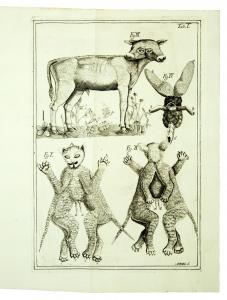De Conchis minus notis liber cui accessit specimen aestus reciproci maris superi ad littus portumque Arimini.
Eur 3,900 / USD 4,200
The price shown on each item does not include V.A.T (Value Added Tax). As a result of the recent EU legislation we are required to charge our EU customers the percentage of V.A.T. charged by the customer’s country of residence, unless they possess a V.A.T. registration number. Postage Additional.
Venetiis, Typis Joannis Baptistae Pasquali, 1739. 4to (260 x 190mm). pp. 88, with woodcut title vignette and 5 engraved folded plates (Together with:) IDEM. De Monstris ac Monstrosis quibusdam ad Josephum Puteum sanctissimi D.N. Benedicti XIV Pontificis Maximi... Venetiis, Typis Joannis Baptistae Pasqualis, 1749. 4to. pp. (36), with woodcut title vignette and 3 folded engraved plates (Together with:) COLONNA, F. Phytobasanos cui accessit Vita Fabi et Lynceorum notitia adnotationesque in Phytobasanon Iano Planco Ariminensi... Florentiae, I.P. Aere, & Typis Petri Caietani Viviani, 1744. 4to. pp. (2), 52, 134, (2), with engraved title vignette and 38 engraved plates. Contemporary vellum, spine with gilt lettering.
The fine plates show marine animals of the Adriatic sea such as shells and crustacean
Janus Plancus is the pseudonym of S.G. Bianchi. Bianchi (1693-1775) who was a physician, scientist and polygraph from Rimini. The first work is the first edition. The fine plates show marine animals of the Adriatic sea such as shells and crustacean. The book also gives one of the earliest descriptions of foraminifera which were collected by the author on the beach of Rimini. "... Plancus versuchte, Schalen lebender Thiere zu finden, welche Ammonshörnern in ihrer Bildung entsprachen. Er schilderte einige analoge, aber mikroskopische Schalen... Hiermit wurden die Rhizopodenformen entdeckt, welche man.. heute Polythalamien nennt" (Carus p. 458). The second work is the first edition and a study of zoological and botanical deformations. The third work is the second edition of Colonna's famous work, first published in 1592 and edited by Plancus. The first edition of the 'Phytobasanos' was the first botanical work with etched plates. The plates were by the author Fabio Colonna, an Italian laywer, scientist (1567-1650). He was a distinguished botanist and is credited with the dicovery of about 80 new plants. Giovanni Bianchi is burried in the church of Sant'Agostino in Rimini and on his funeral monument the following surprising text is found "Nascitur Infelix, Vixit Infelicior, Obiit Infelisissime" (He was born unhappy, he lived more unhappy, he died maximally unhappy). An interesting and rare collection of Plancius' works.
I: Cobres p. 424; II: Cobres p. 294; III: Cobres p. 511.













